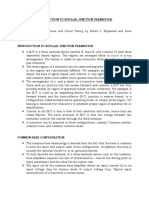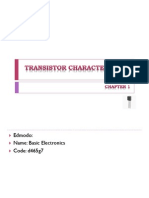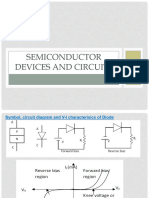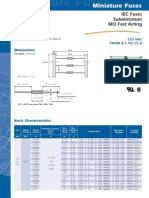Common Emitter Curves:: BE 1 B CE
Common Emitter Curves:: BE 1 B CE
Uploaded by
Harish KumarCopyright:
Available Formats
Common Emitter Curves:: BE 1 B CE
Common Emitter Curves:: BE 1 B CE
Uploaded by
Harish KumarOriginal Title
Copyright
Available Formats
Share this document
Did you find this document useful?
Is this content inappropriate?
Copyright:
Available Formats
Common Emitter Curves:: BE 1 B CE
Common Emitter Curves:: BE 1 B CE
Uploaded by
Harish KumarCopyright:
Available Formats
Common Emitter Curves:
The common emitter configuration of BJT is shown in fig. 1.
Fig. 1 In C.E. configuration the emitter is made common to the input and output. It is also referred to as grounded emitter configuration. It is most commonly used configuration. In this, base current and output voltages are taken as impendent parameters and input voltage and output current as dependent parameters VBE = f1 ( IB, VCE ) IC = f2( IB, VCE )
Input Characteristic:
The curve between IB and VBE for different values of VCE are shown in fig. 2. Since the base emitter junction of a transistor is a diode, therefore the characteristic is similar to diode one. With higher values of VCE collector gathers slightly more electrons and therefore base current reduces. Normally this effect is neglected. (Early effect). When collector is shorted with emitter then the input characteristic is the characteristic of a forward biased diode when VBEis zero and IB is also zero.
Fig. 2
Lecture -13: Common Emitter Configuration
Output Characteristic:
The output characteristic is the curve between VCE and IC for various values of IB. For fixed value of IB and is shown in fig. 3. For fixed value of IB, IC is not varying much dependent on VCE but slopes are greater than CE characteristic. The output characteristics can again be divided into three parts.
Fig. 3 (1) Active Region: In this region collector junction is reverse biased and emitter junction is forward biased. It is the area to the right of VCE = 0.5 V and above IB= 0. In this region transistor current responds most sensitively to I B. If transistor is to be used as an amplifier, it must operate in this region.
If dc is truly constant then IC would be independent of VCE. But because of early effect, dc increases by 0.1% (0.001) e.g. from 0.995 to 0.996 as VCE increases from a few volts to 10V. Then dcincreases from 0.995 / (1-0.995) = 200 to 0.996 / (1-0.996) = 250 or about 25%. This shows that small change in reflects large change in . Therefore the curves are subjected to large variations for the same type of transistors.
(2) Cut Off: Cut off in a transistor is given by IB = 0, IC= ICO. A transistor is not at cut off if the base current is simply reduced to zero (open circuited) under this condition, IC = IE= ICO / ( 1-dc) = ICEO The actual collector current with base open is designated as ICEO. Since even in the neighborhood of cut off, dc may be as large as 0.9 for Ge, then IC=10 ICO(approximately), at zero base current. Accordingly in order to cut off transistor it is not enough to reduce IB to zero, but it is necessary to reverse bias the emitter junction slightly. It is found that reverse voltage of 0.1 V is sufficient for cut off a transistor. In Si, the dc is very nearly equal to zero, therefore, IC = ICO. Hence even with IB= 0, IC= IE= ICO so that transistor is very close to cut off. In summary, cut off means IE = 0, IC = ICO, IB = -IC = -ICO , and VBE is a reverse voltage whose magnitude is of the order of 0.1 V for Ge and 0 V for Si. Reverse Collector Saturation Current ICBO: When in a physical transistor emitter current is reduced to zero, then the collector current is known as ICBO (approximately equal to ICO). Reverse collector saturation current ICBO also varies with temperature, avalanche multiplication and variability from sample to sample. Consider the circuit shown in fig. 4. VBB is the reverse voltage applied to reduce the emitter current to zero. IE = 0, IB = -ICBO
If we require, VBE = - 0.1 V Then - VBB + ICBO RB < - 0.1 V
Fig. 4 If RB = 100 K, ICBO = 100 m A, Then VBB must be 10.1 Volts. Hence transistor must be capable to withstand this reverse voltage before breakdown voltage exceeds. (3).Saturation Region: In this region both the diodes are forward biased by at least cut in voltage. Since the voltage V BE and VBC across a forward is approximately 0.7 V therefore, V CE = VCB + VBE = - VBC + VBE is also few tenths of volts. Hence saturation region is very close to zero voltage axis, where all the current rapidly reduces to zero. In this region the transistor
collector current is approximately given by V CC / R C and independent of base current. Normal transistor action is last and it acts like a small ohmic resistance.
Lecture -13: Common Emitter Configuration Large Signal Current Gain dc :The ratio Ic / IB is defined as transfer ratio or large signal current gain bdc
Where IC is the collector current and IB is the base current. The bdc is an indication if how well the transistor works. The typical value of bdc varies from 50 to 300. In terms of h parameters, b dc is known as dc current gain and in designated hfE ( b dc = hfE). Knowing the maximum collector current and bdc the minimum base current can be found which will be needed to saturate the transistor.
This expression of bdc is defined neglecting reverse leakage current (ICO). Taking reverse leakage current (ICO) into account, the expression for the bdc can be obtained as follows: bdc in terms of adc is given by
Since, ICO = ICBO
Cut off of a transistor means IE = 0, then IC= ICBO and IB = - ICBO. Therefore, the above expression bdc gives the collector current increment to the base current change form cut off to IB and hence it represents the large signal current gain of all common emitter transistor
You might also like
- BJT PPT PresentationDocument32 pagesBJT PPT PresentationMylavarapu Sripritham100% (1)
- AnaloG Layout Interview QuestionsDocument2 pagesAnaloG Layout Interview QuestionsHarish Kumar100% (2)
- Electrical Machines 1 EE05: Engr. Ruben J. Dichoso InstructorDocument17 pagesElectrical Machines 1 EE05: Engr. Ruben J. Dichoso InstructorAngeli Mae SantosNo ratings yet
- Analog Electronics:: AssignmentDocument15 pagesAnalog Electronics:: AssignmentRenuka SarmishtaNo ratings yet
- EdcDocument21 pagesEdcThiaga RajanNo ratings yet
- Bipolar Junction TransistorDocument28 pagesBipolar Junction TransistorRAFAEL ALCARAZNo ratings yet
- Bipolar Junction Transistors Lecture 2 BJT 1 RevADocument30 pagesBipolar Junction Transistors Lecture 2 BJT 1 RevAKoh Jiun HaoNo ratings yet
- Lecture - 10:: Biploar TransistorDocument21 pagesLecture - 10:: Biploar TransistorGEORGENo ratings yet
- Code: DE06 Subject: Basic Electronics: CE BE CDocument1 pageCode: DE06 Subject: Basic Electronics: CE BE Csanshinde10No ratings yet
- Lec 2 ElecDocument18 pagesLec 2 Elecomarfawzi2002oNo ratings yet
- Bipolar Junction TransistorsDocument26 pagesBipolar Junction TransistorsEng Abdulkadir MahamedNo ratings yet
- 4 - BJTsDocument15 pages4 - BJTsSethiSheikhNo ratings yet
- Chapter 4 Transistor CharacteristicsDocument23 pagesChapter 4 Transistor CharacteristicsHydian Genos YTNo ratings yet
- Chapter 4Document18 pagesChapter 4Waqas Ahmad GhummanNo ratings yet
- Applied Ellectronics and IntrumentationDocument31 pagesApplied Ellectronics and IntrumentationPreeNo ratings yet
- Chapter 4Document45 pagesChapter 4api-394738731No ratings yet
- IV. Bipolar Junction Transistors: LED 10302: Introduction To Electronics Meet Prepared By: AZO, AZJ, ATA, MSHDocument9 pagesIV. Bipolar Junction Transistors: LED 10302: Introduction To Electronics Meet Prepared By: AZO, AZJ, ATA, MSHNaim NizamNo ratings yet
- Prof.. Mohammed Gulam AhamadDocument75 pagesProf.. Mohammed Gulam AhamadMohammad Gulam Ahamad100% (1)
- CE ConnectionDocument18 pagesCE Connectionaye1216shaNo ratings yet
- BJT SummaryDocument65 pagesBJT SummaryRutendo SedeyaNo ratings yet
- SSD 2Document51 pagesSSD 2Shahriyar ShantoNo ratings yet
- TransistorsDocument75 pagesTransistorsMuhammad AzzarkasyiNo ratings yet
- Experiment 3: Common Emitter CharacteristicsDocument6 pagesExperiment 3: Common Emitter CharacteristicsAhmed SalehNo ratings yet
- Experiment No 10Document9 pagesExperiment No 10saad akhtarNo ratings yet
- Solution - Assignment 4 - TransistorsDocument14 pagesSolution - Assignment 4 - Transistorsshirsodey21No ratings yet
- Bipolar Junction Transistors (BJTS) : S. Hashim BukhariDocument55 pagesBipolar Junction Transistors (BJTS) : S. Hashim BukharinasiruddinNo ratings yet
- Bipolar Junction TransistorDocument6 pagesBipolar Junction TransistorPadirikuppam PavithraNo ratings yet
- Lecture 4. BJTPPTDocument52 pagesLecture 4. BJTPPTjthanikNo ratings yet
- Analogue Electronic Design Module E EEE2039 / EEE2026 / EEE2042Document36 pagesAnalogue Electronic Design Module E EEE2039 / EEE2026 / EEE2042Arvish RamseebaluckNo ratings yet
- TransistorDocument93 pagesTransistorIbnu Zaqi Firdaus100% (2)
- Bipolar TransistorDocument19 pagesBipolar TransistorD'ganang SamudraNo ratings yet
- Transistor Characteristics and ParametersDocument13 pagesTransistor Characteristics and Parameterspuser007No ratings yet
- Experiment 11: NPN BJT Common Emitter CharacteristicsDocument7 pagesExperiment 11: NPN BJT Common Emitter CharacteristicsMalikAlrahabi100% (1)
- Bipolar Junction TransistorsDocument38 pagesBipolar Junction TransistorsMuhammad AbdullahNo ratings yet
- Unit-2 BJT PrintDocument22 pagesUnit-2 BJT PrintAhan TejaswiNo ratings yet
- Bipolar Junction TransistorsDocument55 pagesBipolar Junction Transistorshuy PhamNo ratings yet
- Unit 4Document15 pagesUnit 4Ama Serwaa YeboahNo ratings yet
- Transistors: Transfer ResistorDocument75 pagesTransistors: Transfer ResistorMuhammadAfriNo ratings yet
- Transistors: Transfer ResistorDocument75 pagesTransistors: Transfer ResistorNagarajan RajaNo ratings yet
- 1.5 Bipolar Junction TransistorDocument65 pages1.5 Bipolar Junction Transistor727723euee070No ratings yet
- Factors Affecting The Operating PointDocument3 pagesFactors Affecting The Operating Pointrsgtd dhdfjdNo ratings yet
- Module 3Document10 pagesModule 3Joseph JohnNo ratings yet
- Lecture 6Document10 pagesLecture 6Altaher Bushra AdamNo ratings yet
- 21 BJT Circuits, Gain and DesignDocument21 pages21 BJT Circuits, Gain and DesignRahul MandalNo ratings yet
- Bipolar Junction Transistor (BJT)Document42 pagesBipolar Junction Transistor (BJT)Muhammad AmeenNo ratings yet
- Transistor CharacteristicsDocument44 pagesTransistor Characteristicsnidhi100% (1)
- 3.1 BJTransistors pt1 Rev2.3 LectDocument37 pages3.1 BJTransistors pt1 Rev2.3 LectShudermawan JarumanNo ratings yet
- L3 BJT DC AnalysisDocument41 pagesL3 BJT DC AnalysisKershaw JosephNo ratings yet
- Exp 8Document12 pagesExp 8DhyanNo ratings yet
- Lecture No. 7 Learning ObjectivesDocument7 pagesLecture No. 7 Learning ObjectivesAbdul RehmanNo ratings yet
- Publication 12 4449 82Document10 pagesPublication 12 4449 82Samz AdrianNo ratings yet
- CH 3Document25 pagesCH 3avishek aviNo ratings yet
- Topic 4: Bipolar Junction TransistorsDocument188 pagesTopic 4: Bipolar Junction TransistorsbhargaviNo ratings yet
- I. Basic BJT Application & DC BiasingDocument20 pagesI. Basic BJT Application & DC BiasingNaim NizamNo ratings yet
- Transistor in Common Base (Continuation) and Common Emitter ConfigurationDocument14 pagesTransistor in Common Base (Continuation) and Common Emitter ConfigurationBangla TweaksNo ratings yet
- Module 2 BJT NotesDocument15 pagesModule 2 BJT Noteskirito.panda16No ratings yet
- Transistor ConfigurationsDocument6 pagesTransistor Configurationsdchouhan72004No ratings yet
- VTU Notes Basic ElectronicsDocument22 pagesVTU Notes Basic ElectronicsCicira BNo ratings yet
- Transistors and MOSFETDocument28 pagesTransistors and MOSFETUtkarsh ShuklaNo ratings yet
- Notes On NPN Transistors PDFDocument5 pagesNotes On NPN Transistors PDFVishal KumarNo ratings yet
- Bipolar Junction Transistor (BJT)Document36 pagesBipolar Junction Transistor (BJT)Muhammad Ameen100% (1)
- Easy(er) Electrical Principles for General Class Ham License (2015-2019)From EverandEasy(er) Electrical Principles for General Class Ham License (2015-2019)Rating: 5 out of 5 stars5/5 (1)
- 3.4 Hazards/Glitches and How To Avoid Them: 3.4.1 The Problem With HazardsDocument8 pages3.4 Hazards/Glitches and How To Avoid Them: 3.4.1 The Problem With HazardsHarish KumarNo ratings yet
- Ece260b w05 Design StyleDocument57 pagesEce260b w05 Design StyleHarish KumarNo ratings yet
- MMTS Train Timings - Hyderabad MMTS Train Timings - Hyderabad Metro Train Timings - MMTS Timetable - Local Train Timings - MMTS HyderabadDocument5 pagesMMTS Train Timings - Hyderabad MMTS Train Timings - Hyderabad Metro Train Timings - MMTS Timetable - Local Train Timings - MMTS HyderabadHarish KumarNo ratings yet
- Diffie-Hellman and Its Application in Security Protocols: ISO 9001:2008 CertifiedDocument5 pagesDiffie-Hellman and Its Application in Security Protocols: ISO 9001:2008 CertifiedHarish KumarNo ratings yet
- 1 Quick Tour v1.0Document33 pages1 Quick Tour v1.0Harish KumarNo ratings yet
- CryptographyDocument37 pagesCryptographyHarish Kumar0% (1)
- Logical Composition of Zero-Knowledge Proofs: Andrew Clausen, HTTP://WWW - Econ.upenn - Edu/ Clausen October 6, 2007Document4 pagesLogical Composition of Zero-Knowledge Proofs: Andrew Clausen, HTTP://WWW - Econ.upenn - Edu/ Clausen October 6, 2007Harish KumarNo ratings yet
- EE/CE 4325/6325 VLSI Design: Introduction To CAD Tools by Akshay Sridharan Akshay - Sridharan@utdallas - EduDocument19 pagesEE/CE 4325/6325 VLSI Design: Introduction To CAD Tools by Akshay Sridharan Akshay - Sridharan@utdallas - EduHarish KumarNo ratings yet
- Eda ToolsDocument5 pagesEda ToolsHarish KumarNo ratings yet
- Approaches To Low-Power Implementations of DSP SystemsDocument22 pagesApproaches To Low-Power Implementations of DSP SystemsHarish KumarNo ratings yet
- 0.18 Um Low Noise AmplifierDocument66 pages0.18 Um Low Noise AmplifierHarish Kumar100% (1)
- CfuDocument3 pagesCfuHarish KumarNo ratings yet
- Cambridge IGCSE Physics by Tom Duncan and Heather KennettDocument2 pagesCambridge IGCSE Physics by Tom Duncan and Heather KennettMOKHOBONo ratings yet
- Clipper ClamperDocument6 pagesClipper ClamperMannan AbdulNo ratings yet
- Service Manual: WWW - Sbskg.co - RsDocument5 pagesService Manual: WWW - Sbskg.co - RsVeljkoNo ratings yet
- 1.3. Tya-110 - 3Document12 pages1.3. Tya-110 - 3Reza AfarandNo ratings yet
- Miniature FusesDocument88 pagesMiniature FusesEliasNo ratings yet
- Turnstile Datasheet PDFDocument16 pagesTurnstile Datasheet PDFRenNo ratings yet
- Capacitance Exercise Solution (English+Hindi)Document113 pagesCapacitance Exercise Solution (English+Hindi)Raj Rajeshwer Gupta100% (1)
- MAACP2-0: Acopos User S ManualDocument206 pagesMAACP2-0: Acopos User S ManualjoeNo ratings yet
- Calculation:: Calculate No of Lighting Fixtures / Lumen For Indoor LightingDocument1 pageCalculation:: Calculate No of Lighting Fixtures / Lumen For Indoor LightingPrajjwal Tak33% (3)
- A) A Distribution Panel With 2000A TP ACB Incomer With Ammeter and Selector SwitchDocument5 pagesA) A Distribution Panel With 2000A TP ACB Incomer With Ammeter and Selector SwitchAayush AgrawalNo ratings yet
- NDT Request Form CIWE-RT-133Document4 pagesNDT Request Form CIWE-RT-133GomathyselviNo ratings yet
- Abstract of IE RulesDocument6 pagesAbstract of IE RulesNavneet SinghNo ratings yet
- WO 33-4 Shastri Bridge Panel Cost R0 25.09.2021 - FINALDocument27 pagesWO 33-4 Shastri Bridge Panel Cost R0 25.09.2021 - FINALJayashree GopalakrishnanNo ratings yet
- Static Electricity 1 QPDocument11 pagesStatic Electricity 1 QPjuanfogedaNo ratings yet
- United Electric Series 12 PS Adjustment DataDocument2 pagesUnited Electric Series 12 PS Adjustment DataskinkcrowNo ratings yet
- U 5 P 2 UbmtsDocument47 pagesU 5 P 2 UbmtsAmara Sanjeevaiah GandhiNo ratings yet
- System 4000 500W Declaration of ConformityDocument8 pagesSystem 4000 500W Declaration of ConformityPalaKhartikeyanNo ratings yet
- Everlight Electronics Co.,Ltd.: Technical Data Sheet 2.3" 8 8 Dot Matrix DisplaysDocument5 pagesEverlight Electronics Co.,Ltd.: Technical Data Sheet 2.3" 8 8 Dot Matrix DisplaysStuxnetNo ratings yet
- CT Site Test Report Current Transformer: Pre-Commissioning ChecklistDocument6 pagesCT Site Test Report Current Transformer: Pre-Commissioning ChecklistNaveed100% (1)
- Sample Panel Board Details W/ Load ScheduleDocument1 pageSample Panel Board Details W/ Load SchedulekgmengineeringservicesNo ratings yet
- Ee 3112 - Electrical Installation Design I-Lect 3-Part1Document10 pagesEe 3112 - Electrical Installation Design I-Lect 3-Part1Dilash EkanayakaNo ratings yet
- DC Short Circuit Fault Analysis and Protection of Ring Type DC MicrogridDocument7 pagesDC Short Circuit Fault Analysis and Protection of Ring Type DC Microgridmusharraf saeedNo ratings yet
- Samsung 732n Plus 932b Plus 932n Plus CH Ls17pea Ls19peb Ls19pea PDFDocument83 pagesSamsung 732n Plus 932b Plus 932n Plus CH Ls17pea Ls19peb Ls19pea PDFRafael Enrique Moyeja100% (1)
- TR - Electric VehiclesDocument47 pagesTR - Electric VehiclesMohamed GamalNo ratings yet
- Problemsinelectr00lyonrich PDFDocument224 pagesProblemsinelectr00lyonrich PDFNiteshNarukaNo ratings yet
- Display LED 7 SegmentosDocument1 pageDisplay LED 7 SegmentosronywillyNo ratings yet
- Opc LM1 PRDocument13 pagesOpc LM1 PRmohamed demerdash100% (1)
- Chapter 2 - Transformers PDFDocument25 pagesChapter 2 - Transformers PDFAmmar Safwt0% (1)
- Limitswitch HoneywellDocument17 pagesLimitswitch HoneywellZahira Yadira Arévalo MéndezNo ratings yet






































































































